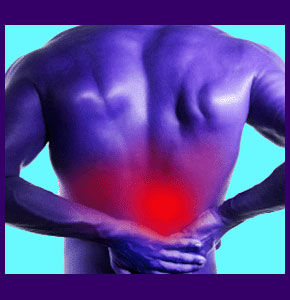
Back pain when raining is a common patient report linking increased dorsalgia symptoms to changes in weather, humidity and barometric pressure. Each year, we get many reader letters stating a definitive belief that pain worsens when the climate becomes stormy. Medical science has long known that rainy weather seems to exacerbate many problematic and painful health conditions. In fact for a very long time, one of the most common health disorders, rheumatism, was blamed almost exclusively on anatomical reactions to damp and depressing weather patterns.
While definite research support is lacking, popular opinion still demonstrates an apparent relationship between nasty weather and the existence of various types of chronic pain syndromes. We have found both anatomical and mindbody explanations that support patient citations of symptomatic escalation and intend to detail these findings in this unique scholarly essay.
Back Pain from Rain, Humidity and Low Pressure
Rain is just part of the weather-related back pain picture. Equal numbers of patients cite similar expressions from high humidity, low barometric pressure and the generally damp, unpleasant conditions associated with storms. People who live in certain locales that regularly feature these weather patterns often report statistically higher rates of recurrent and chronic back pain than people who live in geographic locations that feature calmer, drier and more enjoyable climates.
We have corresponded with many patients over the years who were told to relocate by their very traditionally-minded physicians. Often, there would be no clear cut reasoning given why this recommendation was made, just that “many people” may have found relief by moving from a problematic climate to a more hospitable region of the world. In fact, these types of medical prescriptions are one of the main reasons for the development of “retirement living” communities in certain sections of the world that appeal to people seeking particular climatic patterns.
For much of the nineteenth and early twentieth centuries, the diagnosis of rheumatism was one of the most common conditions found in medical literature, as well as in clinical practice. Patients were deemed to suffer a variety of muscle aches and flu-like symptoms due to exposure to wet, foggy or inclement weather. Back pain when raining seems credible, given these ideas. Although the “modern medical age” ended the epidemic diagnosis of weather-related rheumatic conditions, a large number of patients still report climate-induced symptomology in terms of joint pain, back pain, neck pain and other common conditions.
Back Pain When Raining Explained
Humidity has been theorized to increase cellular moisture content, causing fluid retention at microscopic degrees. In patients who already demonstrate an inflammatory process, this could explain why pain is increased in moisture-rich weather.
Low barometric pressure, the exact type almost always associated with rainy conditions, is the main suspected culprit for weather-related pain problems. Decreased atmospheric pressure allows every cell of the body to expand, once again at a microscopic level, potentially increasing inflammatory and compression syndromes in the spinal nerves, muscles or anywhere in the anatomy. Patients who already suffer compressed or borderline compressed neurological tissues might experience increased symptomology when these already compromised structures further expand under the lower barometric pressure.
Both of these explanations are a bit of a stretch of creative medical theory, but could have some basis in science and actual presentation. However, there is a much more plausible theory that may explain the weather’s contribution to various pain syndromes. The most logical influence of weather on health comes through the mindbody interactions.
Mindbody factors are certainly credible when discussing weather-related effects on pain. Patients might believe they will suffer increased symptoms due to any external factor and will therefore actually experience their expectations due to a programmed response. Programming is a proven occurrence in humans that explains the causation and cessation of many health issues. If patients are told that they might suffer pain due to turbulent weather patterns, they might also experience these actual symptoms due to pure nocebo reaction, rather than any actual organic provocation.
Inclement weather is also known to produce negative emotional consequences that can diminish mood, possibly creating an exacerbating psychological overlay to existing pain conditions.
Back Pain When Raining Synopsis
Whether the weather actually causes escalated pain through a physical or psychoemotional mechanism is actually quite irrelevant. The point is that enough patients cite climate-related effects on their health to have doctors take the matter very seriously, despite a lack of clinical evidence pointing out definitive and scientifically proven explanations for this occurrence. I do not think that given such a broad possibility of symptomatic escalation involving both possible physical and potential emotional factors, any clinical medicine provider would dispute that weather may hold more sway over our health than we know.
Ironically, many doctors are far less convinced that the actual underlying cause of back or neck pain might also be purely psychogenic, even though they will concede that external factor, such as weather, might enact emotionally-driven contributors to the problem. It is really illogical, unless you consider that without a structural element of pain causation, patients will not longer seek out medical care for the staggering number of dorsalgia problem each year, literally putting some doctors out of business. So, if your expect doctors to see the big picture when it comes to the mindbody influence on back pain, do not hope for too much. I guess we must be happy with the small concessions they make, such as the possible emotional influence of rain on our health.





